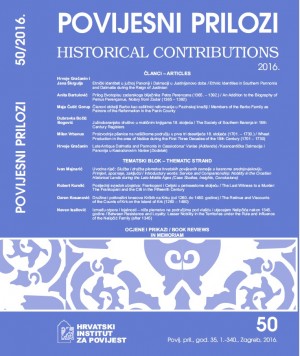Hodočasnici palmieri iz Poljske i Litve u hrvatskim primorskim krajevima (1400. – 1600.) uz osvrt na Latvijce i Estonce
Palmieri from Poland and Lithuania at the Croatian Coast (1400-1600), with Reference to the Latvian and Estonian Pilgrims
Author(s): Krešimir KužićSubject(s): Cultural history, 15th Century, 16th Century, 17th Century, History of Religion
Published by: Hrvatski institut za povijest
Keywords: Poland; Lithuania; pilgrims; Holy Land; Croatia; Adriatic Sea;
Summary/Abstract: As a universal European Christain phenomenon, pilgrimages focused particularly on three main destinations: Jerusalem, Rome, and Compostela. In the period from the late 14th until the early 17th century, several dozens of identified pilgrims from Poland and Lithuania travelled on ships along the Croatian Adriatic Coast, heading for Jerusalem. However, within this overall picture there are several common traits and differences. As for their motives, they were similar in all countries and consisted of elements related to their religious or estate identity. Owing to its early Christianization and an elaborate network of Franciscan monasteries, Poland was more advanced in terms of pilgrimage than Lithuania. On the other hand, among the Lithuanian pilgrims one fi nds many Orthodox Christians, which reflects the country’s ethnical structure. As for the estates, it can be observed that there were not many commoners among the Polish pilgrims, while the nobility and clergy are present in almost equal numbers. It is especially among the nobility of both countries that gaining the title of miles Sepulchri Domini played an important role in terms of motivation. Pilgrims from Poland and Lithuania used exclusively the route through Austria and Hungary, their destination being Venice as the place of embarkment on ships.
Journal: Povijesni prilozi
- Issue Year: 2018
- Issue No: 54
- Page Range: 101-136
- Page Count: 36
- Language: Croatian

